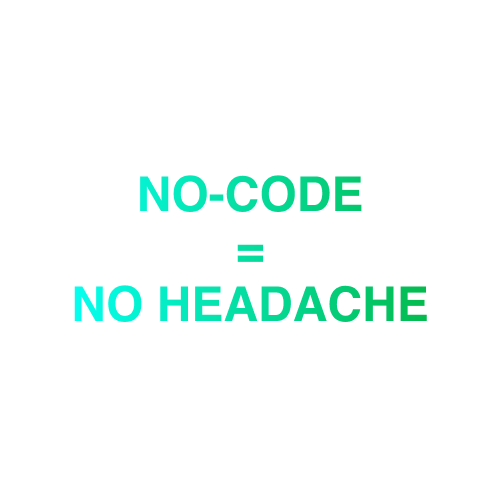Common Mistakes in No-Code App Development and How Testing Automation Helps Fix Them
No-code app development is popular today, but inexperienced developers can make mistakes. We describe the most common ones and present the opportunities of codeless test automation tools that help find and prevent issues.

Startups and individual developers build and launch products quicker with the help of no-code app development. Web and mobile apps, workflow automation solutions, and some other digital projects. There are, however, some challenges and bottlenecks that you can face in the process.
In this blog post, we will talk about the most common mistakes and difficulties of using no-code tools. Even if you develop a solution without writing any new code, you will have to test how everything works, and codeless test automation is the fastest way to check the UI, functionality, performance, and other vital facets of a successful app.
Low-Code / No-Code App Development: What is the Difference?
There is a common misconception that building apps with no-code development platforms means you will never use any code. Is it really so? Can you build an app without coding? The answer is – yes and no. Yes, you can develop a fully-functional app without having to write custom code. But no, it doesn’t mean that your project exists without a single line of code.
What is no-code app development? It is a process of creating mobile and web solutions in a breeze, almost like drawing everything on a sheet of paper.
No-code app development platforms allow non-technical people to apply drag-and-drop interfaces to put all necessary elements together building apps that have complete functionality and UX/UI design. Efficiency and user-friendliness are the best qualities of such platforms. No-code app builders are really good for MVP development and internal corporate projects.
The main difference between a no-code app development platform and a low-code app builder is how much technical competence you need to use it.
Low-code solutions provide much more flexibility because they combine the convenience of graphical user interfaces with opportunities for human programming. Naturally, if you are a non-technical team using low-code software, you will need at least one specialist with coding skills. Scalability is the best quality of such solutions – they allow developers to customize designs without limits, use open APIs, set additional configurations, etc.
Is no-code or low-code better than coding? It depends on your goal. If you want fast and simple results or if you prepare to validate your idea, no-code tools can save a lot of trouble. However, if you are planning to scale your product in the future, we advise you to consider custom coding with modern programming languages and frameworks.
All in all, the purpose of low-code/no-code app development is the same – to make the app building process faster, cost-effective and more convenient for users without a profound technical background.

As programmers and engineers do not usually take part in no-code development, there are some challenges related to business logic implementation, digital security, and future scalability.
Now let’s be more specific about the challenges you can face while building and launching a project that has no-code architecture. We will also dive into the many advantages of no-code testing tools that your team can use when testing the product before launch.
The Most Common Mistakes in No-Code Application Development
Is no-code the future of software development? It may be too early to say for sure, but the fact that many businesses started using this technology speaks for itself. Companies have a lot of ways to apply no-code and low-code tools – according to Statista. Unfortunately, some mistakes often happen when it comes to no-code web and mobile app software development.
Mistake #1: Choosing the Wrong App Builders
If you are inexperienced, it is easy to select a tool based solely on its friendly UI or positive reviews. There are, however, several important points that you should consider in the first place:
- Is your project web or mobile? For example, Adalo is a great tool for PWA no-code app development while Bravo allows you to successfully build native iOS and Android apps.
- What kind of app are you making? There are different builders for eCommerce apps, voice assistants, CRM solutions, and other projects.
- How complex is your future solution? This may include features, databases, APIs, no-code integrations, etc. Some no-code app development platforms are simply better for complicated projects.
- What kind of functionality do you need for productive work on this particular project? For example, customizable typography and colors, the use of Excel and/or Google Sheets, keyword search, advanced collaboration options, etc.
Mistake #2: Ignoring Data Security Capabilities
Security is highly important for many businesses that deal with customer information, financial transaction data, etc. However, some startups are careless and do not properly research what kind of security protocols has the no-code enterprise application development platform that they use for building a new solution.
As a result, you may face data leaks, hacking attacks, and more threats. Choosing a reliable tool should be a number one priority before you start building apps, testing, and launching them.
Moreover, it makes sense to make sure that the tools you are using remain compliant with data protection regulations in your region or country.
Mistake #3: Being Incoherent in the Development Process
No-code developers are often inexperienced in making the process of app development strategic and coherent. Here are some pieces of advice on how to put everything together and avoid delays.
- Define a clear goal, project objectives and milestones.
- Work through the business logic and choose the right tool for app development that fits the way users will interact with your app.
- Think about ways to scale your project in the future.
- Do not underestimate the importance of test automation – testing tools and best practices of testing allow developers to stay on track and identify any problems timely.
Now is the time to look closely at the testing practices for codeless mobile and web applications to see how test automation allows to effectively detect and prevent common mistakes.
Why Your No-Code Project Needs Codeless Test Automation To Detect Mistakes
The ultimate goal of no-code tools for testing activities is to provide more opportunities for QA specialists and non-technical startup founders, business analysts, project managers, etc.
Here is how you can overcome many no-code development challenges using no-code test automation tools.
- Early problem detection: thanks to codeless testing tools, you can find bugs at the very first steps of the app building process. In addition, special integrations ensure faster launch and regular updates.
- Effective reusability: test recording and reuse of created test cases is a great feature of no-code automation testing tools that empowers no-code developers to easily speed up the whole process and save resources.
- Increased testing coverage: codeless platforms allow you to conduct various kinds of tests simultaneously on multiple devices, operating systems, browsers, etc.
- The higher quality of testing: no-code automation means removing human error from the testing process and getting faster and more frequent feedback. All these advantages allow your team to finish the project without serious issues and bugs.
- Built-in integrations: codeless testing tools often provide a no-code developer with effective libraries and templates, as well as means of test management and project communication.
- AI and ML: they allow you to upgrade the testing process in a way that manual efforts are not able to provide.
- Real-time analytics: interactive dashboards and automatically generated reports provide lots of priceless insights on the strong and weak sides of your development process.
In addition to all these advantages, it’s important to say that the best no-code test automation tools are cloud-based and provide an exceptional level of data security.

You can read more about codeless automation testing silver bullet on our blog and discover a dozen advantages of this type of testing in the process of no-code development.
Now let’s talk about some ways to select the right apps for your no-code development and further testing.
How to Choose from No-Code App Development Platforms
Which no-code app builder is the best? There is no simple answer to this question because every solution presents its own capabilities that may be ideal for one project and practically useless for another.
We will list some points that are worth paying attention to when you choose an app builder.
- Target users. Is this tool for low-code/no-code application development? If you are making your first app and don’t have practical experience with programming languages, choose from no-code platforms.
- Project type. There are specific no-code app builders for virtual assistants, chatbots, workflow automation apps, eCommerce platforms, data visualization projects, and more. It also makes sense to determine beforehand what kind of testing your project will require during the development stage.
- Free trial or a demo. The best way to understand if this particular tool is the right choice is by getting hands-on experience with it. Pay attention to the technical capabilities and user interface of each no-code app development platform you are trying to use.
- Drag-and-drop user interfaces. This is a feature of many codeless development tools, however, pay special attention to how convenient and intuitive the interface is: drag-and-drop features to organize all elements, drop-down lists to set up your project’s business logic, etc.

How to Choose from Codeless Test Automation Testing Tools
Even if you don’t write custom code manually, you still will need to check your product during and after the development to make sure everything works as it is supposed to, remaining stable and secure.
The way of choosing from a variety of no-code test automation tools is quite similar to finding the right tool for your no-code mobile or web application development project. We recommend selecting a testing platform during the discovery phase. This way, you will know for sure what exactly to check and if you have technical capabilities to do it.
We have already analyzed the 14 best codeless test automation tools and listed their pros and cons. You can define the main objectives of using automated testing for your particular project and choose the platform that fits best with your requirements.
Case #1: You create web applications and need a tool that can generate test scenarios.
Possible solutions: DogQ, Preflight.
Case #2: You need to check a cross-platform application.
Possible solutions: Katalon Studio, Ranorex Studio.
Case #3: You want to test Graphical UI components
Possible solutions: Sikuli.
Case #4: You realize that some parts of your project need AI-based testing.
Possible solutions: DogQ, Perfecto.
Case #5: You develop your first project and don’t have coding skills to deal with advanced QA tools.
Possible solutions: DogQ, BugBug.
Improve Web App Testing Experience with DogQ
DogQ is a beginner-friendly codeless test automation platform for web testing. We created this tool for non-technical specialists working for all types of companies, from small startups to large enterprises. The tool has also received positive feedback from Junior QA engineers.
Here are the top-5 most exciting features of DogQ that make it one of the best no-code test automation tools on today’s market.
- Easy to get started: thanks to the user-friendly UI, you spend less time on adaptation and begin the testing process right away;
- Modern technology-driven: it supports all popular frontend development frameworks and OCR technology;
- Improving testing and development processes: CI/CD integration allows a no-code app developer to notice bugs and defects early and fix them before the product launch;
- Enhancing test management: DogQ has handy features like Test scheduling, Change management, Keyword search, Analytics, and Team management to make testing processes and collaboration most effective;
- Speeding up testing activities: Multiple scenarios generation with in-built test scripts can help you finish all the testing early.
DogQ has many more advantages in comparison with similar tools, which makes it one of the most efficient codeless test automation testing tools for web apps.
